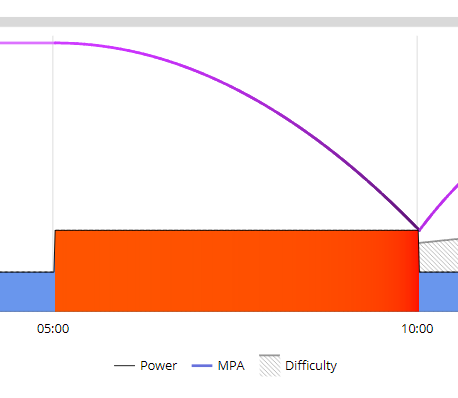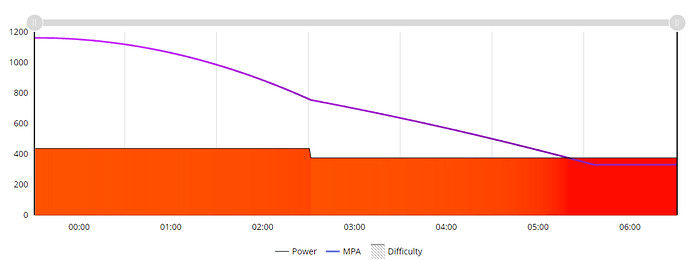There are different types of max efforts
- according to the power-duration curve exactly i.e. you hold your 4MMP for 4 minutes - that’s a max by definition
- you reach failure in some other other way - it’s still maximum in that you couldn’t have done more, but doesn’t touch the curve per the example above
Another simpler example would be say you
- hold 4MMP for 3 minutes (so not a max on the power curve), THEN
- (try to) hold 10MMP for 4 minutes directly after that (also not remotely near a max on the power curve… so the combined effort would also not be a max on the power duration curve)
That would actually lead to a breakthrough under XERT (at least for my signature), which you can see by creating a dummy workout (where MPA crosses power), but wouldn’t trigger anything under ‘other’ systems as they’re referred to:
The reason is that the XERT also takes into account fatigue from the first ‘near max’ effort in assessing the overall impact of the second ‘near max’ effort. You can clearly exhaust yourself by riding at intensities below the power-duration curve
Definitely a paradigm shift in our understanding of exhaustion/maximal efforts. From here forward, a maximum effort is any point where your power output reaches MPA.
I think what’s confusing is that using MMP data will only catch certain maximal efforts - mainly those efforts that are done while fresh until a point of failure is reached, like this:

Xert is able to catch a whole variety of other maximal efforts that would normally be completely missed because we aren’t looking at the average power over some duration, but rather the power that you’re producing every second, such as the example provided earlier.
Here’s another example from the Workout Designer:
- 500 Watts for 30 seconds
- 200 Watts for 30 seconds
- Repeated until failure. In my case that’s at 4:24 with an average power of 363 Watts.
Now look at a constant effort at 363 Watts. Failure this time happens at 6:10. Quite a difference even although both took you to the point of failure.
The first effort would be sub maximal as far as the MMP curve is concerned as you can hold the same average power for 1:46 seconds longer but in Xert the effort is captured and reflected in your Fitness Signature and the Power Curve that is generated from that.
Mike
Yeah, my 363 watt sustained efforts usually fail around that point… 
Not sure I should post that but my Xert thinks I would last about 30 seconds 
But I guess that’s the beauty of the system: It really adapts, even to me 
interesting stuff Scott. What I think is my understanding of the differences between MMP curve data and the MPA/ Hie, TP triad is that with MMP all of these points on a curve have to be under ideal conditions, ie rested, fuelled etc. What Xert does is is completely different and a bit hard to wrapp your head around because there is a fair bit of math under the hood, but it looks at the current situation for that athlete (how fatigued they are for now) based upon what has happened up to the time of the effort. It has calculated how much effort you should have available, call that MPA, and then based upon what you actually do decides if you broke through that limit. If you broke through what your signature thinks (calculates) as you limit then something has changed and often the something is your TP, but it may also be your MPA or your HIE since (though on this point I am fuzzy) they interact.
So break through effort is a much more complex item and why I like XERT because as you get your signature dialed in you have harder and harder work to break through indicating to me you are on a plateau, if break throughs are too easy to achieve there is something that needs to be tweaked in your signature and that happens over time it will eventually dial itself in and all is good.
So it is a very different head set and takes some getting used to. This is what I see as the biggest hurdle that XERT has to get people on side and committed users…
The otehr thing I love about XERT is the smart workouts. This again is based upon an accurate signature but if so then you should not fail to complete a workout if your signature is dialed in or there is something that is impacting your ability to perform that can not be reflected in the signature, like external (work/ life) stress, poor nutrition or fuelling etc.
Scott, Stephen, and Armando, keep up the good work I can’t wait to see where this goes from here.
Thanks, now it’s making sense.
Long standing question for me: is it maximal effort time on the Activity, or the maximal effort time at the previous sig? Example would be, I’ve got :28 on the activity, but if I hit ‘Previous’ it’s 1:13.
You tell me. ![]() We figured your fitness had changed before the ride and not during the ride hence the maximal effort is measured with the new signature.
We figured your fitness had changed before the ride and not during the ride hence the maximal effort is measured with the new signature.
Ha! Sorry, didn’t make that very clear. What I should have said was, I love the idea of looking at maximal effort duration as indication of how ‘good’ the BT effort was. So… when @ManofSteele says ‘1:00 maximal effort time is excellent’, would you base that on what we thought the sig was, or what we now know it is? (I’m thinking it’s on the ‘out of date’ sig).
The out of date signature, is actually your predicted signature with a slight downward adjustment in order pick up variations. If we had perfect data and everything was tuned perfectly, we would predict your signature and you’d never get a breakthrough. ![]() but you’d still have maximal effort time. It would just never generate a breakthrough.
but you’d still have maximal effort time. It would just never generate a breakthrough.
The more time you spend near MPA, the clearer the picture becomes on what your signature actually is. It needs to be on what we now know it is because the out of date signature may have you spending minutes near MPA but after the signature is obtained, it may only turn out to be a few seconds. This is often the case with long efforts just above TP. A small change in TP makes a big change in MPA and so you may go from minutes to a few seconds after the adjustment.



